Deana J. Driver's Blog, page 6
February 1, 2021
A Funny Thing Happened at a Craft Show
I miss craft shows. Actually, I miss seeing real people with their faces visible, but that's another story.
I miss the busy craft show atmosphere of talking with all variety of folks and selling books to interested readers. Craft and trade shows on the Prairies have been part of my life every fall since 2009 when I published The Little Coat: The Bob and Sue Elliott Story by Alan J. Buick. That fall, the author and I and our spouses (Carol and Al) went on an epic author tour through parts of Saskatchewan and Alberta to launch this wonderful book about a Canadian soldier from Olds/Calgary and a Dutch girl who received his troop's wartime gift of a child's coat made from a Canadian Army blanket.
The Little Coat is still one of our most popular titles - for good reason, including the fact that the coat is now an artifact in the Canadian War Museum thanks to Alan's writing efforts - and it launched us into the world of selling our books at trade shows and craft shows as well. We had a trade show booth at big events like Canadian Western Agribition for many years and we took our books on the road to various craft shows in all regions of Saskatchewan as well as southern Manitoba and Alberta. Fun stuff for sure.
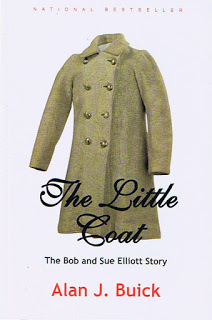
But people do say the darnedest things sometimes.
One of the funniest - or maybe strangest - moments that happened came during a show in a Saskatchewan town in November 2012. The craft show was held in a large gymnasium-like room and there was plenty of space for craft tables and for customers to wander among them. (Sigh. Did I mention that I miss people?)
Anyway, I returned to the room after a short break and an older woman greeted me at the door. She called to her friend to follow her and they both walked behind me, following me for the entire length of the large room until I got to my table. They stopped in front of my table and waited until I sat down in my chair behind the table.
Then the woman picked up my Never Leave Your Wingman book - about fun-loving, inspiring, seven-time cancer survivor Dionne Warner and her wingman husband Graham - and held the bright pink book up for her friend to see.
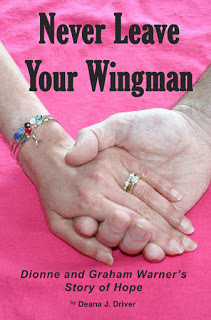
"They say this is a really good book," the woman said to her friend.
Then she put the book down and they both walked away.
What... was... that? I wondered for a long, long time - when I wasn't laughing and shaking my head, that is.
She never did buy the book. Not that weekend anyway.
At another craft show - in a city this time - a woman came up to my booth and asked if she could buy "that big book."
I was confused. All the books I publish are of a standard size - either 6 inches wide by 9 inches high or slightly smaller. I have published only a couple of books that are 8-1/2 inches by 11 inches, so I didn't understand what she was wanting. I asked her to repeat herself.
"I want to buy that big book. There!" she said as she pointed to the 12-inch by 18-inch poster of a book cover that was hanging on the booth wall behind me.
"Um... those are just posters of the book covers. The books are here," I said as gently as I could while I motioned to all the books covering the tables between us.
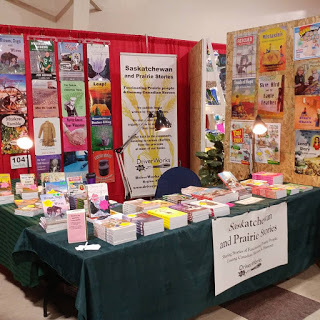
So maybe there's a market out there for oversized books. Hmmm...
As my publishing business grew and my display table of books by various authors expanded during the past 10 years, my routine of briefly introducing the books on my table became more complex. Sometimes the words that came out of my mouth were confusing for craft show visitors and for myself as well. (I'm better at writing than I am at talking.) As I honed my publishing preferences to focus only on non-fiction books and other genres related to non-fiction, it became easier for me to describe the books on my craft show tables. At least that's what I thought was happening.
"Hello. These are all books I publish," I'd say. "They're all written by Saskatchewan and Prairie authors, including me. These ones are all true stories (as I pointed out the books), these are healing and wellness, these are children's fiction and non-fiction, and these are humour and cowboy poetry over here. They're all true stories or based on true stories."
It sounded simple enough to me but, then again, this is my business and I deal with these books daily, so it should sound understandable to the person who creates the books. Let me tell you, it definitely boggles the minds of some folks who wander up to my craft show tables. Usually, I can sort out their questions and help them understand whatever it is that they want to know about the awesome books written by awesome writers. (Shout out to my authors!)
But sometimes, nothing I say really matters.
I recall spending five or ten - or maybe it was a hundred - minutes one day talking to a man about the different books he appeared to be interested in on my craft show tables. He had asked about some of the story lines, whether this one was a Saskatchewan story or not, whether these people were still alive... and more. Then came the question that floored me.
"So, have you read any of them?" he asked.
Uh.... What?
"Yes," I replied, trying to keep him from seeing how astounded I was at his question. Hadn't I just told him about almost Every. Single. One. Of these books?
"I edited and published all of these books, so, yes, I've read every word in every one of them. Many times," I said.
The guy eventually walked away. I was glad to see him go. Sometimes you just can't help people.
The final memorable funny moment came when two young girls, about 10 years old, stopped at my booth one evening and began looking at the children's and young adult books. They picked up one kids' book and then another and began conversing with me.
And that's when my "I've read every word in every one of these books" line came back to haunt me.
One of the young smarty-pants girls picked up The Inquiring Reporter by Clay Stacey (a book that is still available as an e-book, by the way) and randomly opened it up. "Okay, I'm on page 68. The word starts with a p and ends with r. What is it?" the youngster brazenly asked as she looked straight at me.
"Publisher," I replied, without hesitating.
The little girl's eyes opened wide as she looked at her friend in shock. "Wow! She really does know every word in the books!"
She quickly put the book down and they almost ran as they left my booth.
I smiled.
Yes, of course I got lucky with "publisher", but it was a pretty easy guess. The book's author, Clay Stacey, was a publisher, editor, and reporter in all four Western provinces for 50 years - so "publisher" seemed like a reasonable option for a word that starts with p and ends with r - in a book about a publisher!
However, I am glad that she didn't look a little farther down the page and pick out the word starting with a u and ending with a y...
Unpredictability.
January 17, 2021
Students learn about Reconciliation from Mistasiniy: Buffalo Rubbing Stone book by Mary Harelkin Bishop
Saskatoon author and educator Mary Harelkin Bishop wrote Mistasiniy: Buffalo Rubbing Stone with the hope that it would give readers of all ages a better idea of the concept of reconciliation - a path of respectfulness between Indigenous and non-Indigenous people in Canada.
It has been gratifying to see the book receive awards at the Purple Dragonfly Book Awards and Hollywood Book Awards, but the greatest gifts have come when students and teachers send messages about what they learned from reading this book.
Mistasiniy: Buffalo Rubbing Stone tells the story of Danny, who lives on a family farm homesteaded by his great-great-grandparents, and Zach, a Cree boy who lives in the nearby town. When their Grade 6 teacher assigns a Canadian heritage project in which students must write about their family histories, Danny is paired with Zach, the only Indigenous boy in the class. At first, Danny and Zach can’t seem to get along. Then Danny finds out that his great-great-grandmother’s journal talks of breaking the land and building and living in a sod house. She also tells of how the First Nations people in the area helped her save her infant son’s life by using traditional medicines when he was very sick. The more Danny digs into his family’s history, the more he realizes that his and Zach’s pasts are complicated and connected.
A Grade 5/6 classroom in Saskatoon recently read Mistasiniy: Buffalo Rubbing Stone and used a Literature Circles learning format. In images sent via a PowerPoint slideshow, the teacher shared with us what the class learned from this important book:
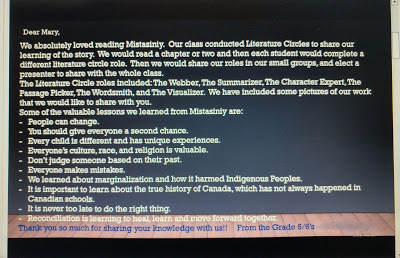
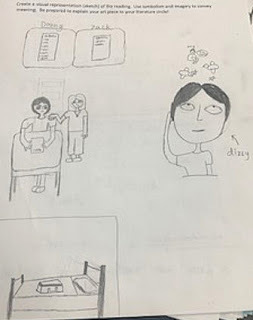
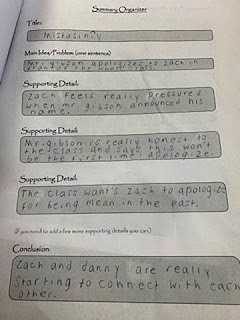
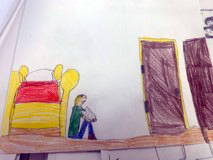
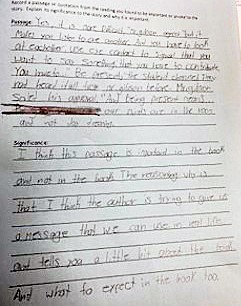
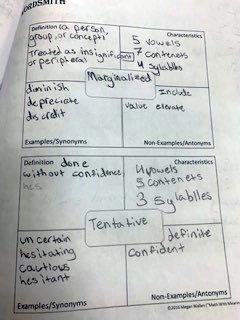
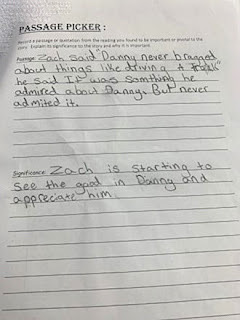
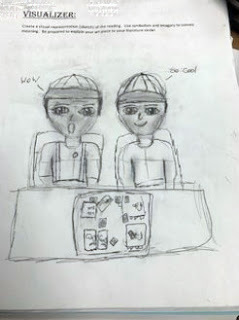
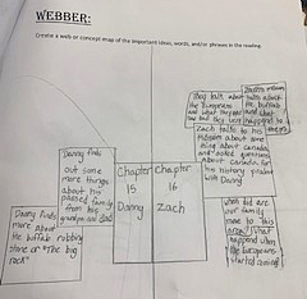
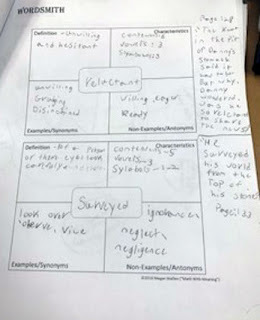
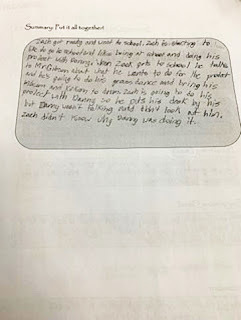
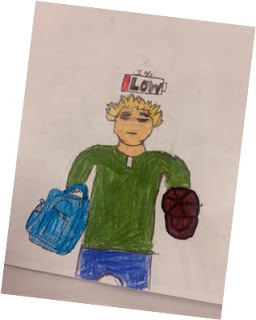
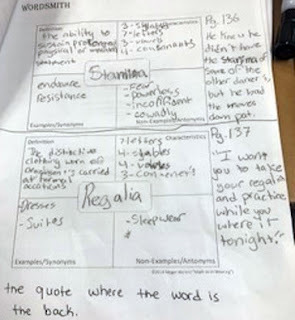
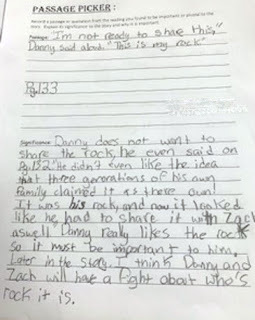
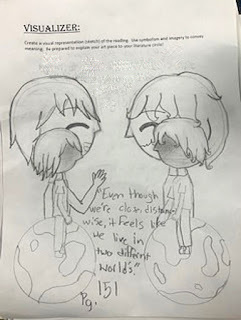
-
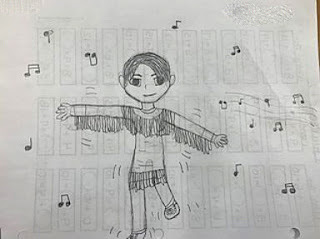
Thank you to the teacher and Grade 5/6 class for sending us their work and responses to this book.
Mistasiniy: Buffalo Rubbing Stone has been called “a must-read book for all youth” and a book that will help teachers become better teachers, kids become better friends, parents become better parents, and neighbours become better neighbours.
The author, Mary Harelkin Bishop, is a retired teacher who spent much of her career working in core neighbourhood schools. She has also been a teacher-librarian. Most recently, she was an educational consultant with Saskatoon Tribal Council, with a focus on helping students research and write the history of their families and reserves, and their hopes for the future.
Mistasiniy: Buffalo Rubbing Stone is available from www.driverworks.ca.
(ISBN 978-1-927570-32-6, Juvenile fiction, Ages 10 and up)
Schools and libraries should contact DriverWorks Ink
directly for discounts on orders.
January 11, 2021
Submissions Call - True stories of Canadian Aviation and Funny Stories about Farm Life
Send in your true stories of adventures in Canadian aviation and your funny stories about life on a farm!
DriverWorks Ink wants to publish your stories in the third volumes of the Flight: Stories of Canadian Aviation book series and the Fun On The Farm: True Tales of Farm Life book series.
Here are the details and deadlines:
Send your story submissions for Flight: Stories of Canadian Aviation, Vol. 3
If you or someone you know has a great story of Canadian aviation to contribute to the next volume of Flight , please send your submission by email or mail. Submissions must be true short stories (no poems please) about events that occurred to Canadian pilots or other aviation personnel. We want true stories of danger, heroism, helping, joy, adventure, silliness, misfortune, etc.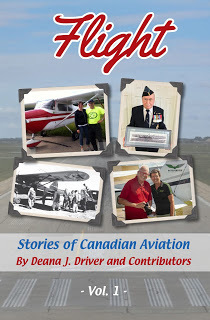
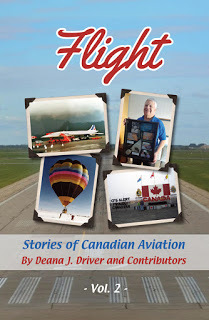
Send your story submissions for Fun On The Farm, Vol. Three
DriverWorks Ink is pleased to invite you to share more of your true short stories (or poems) about funny things that have happened on Prairie farms for Volume Three of the Fun On the Farm series. Tell us about events, interactions, people, or pranks that have happened to you or someone you know related to life on a Prairie farm. We want to make readers giggle, shake their heads in wonder, or downright belly-laugh when reading this book, just as they did with Volumes 1 and 2. Note that we've said "Prairie" farms since most of the stories have happened on the Prairies, but we will entertain stories that occurred on other farms in other Canadian provinces and territories.
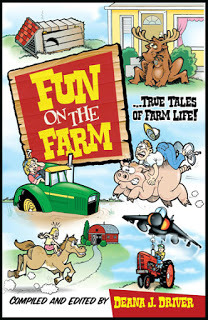
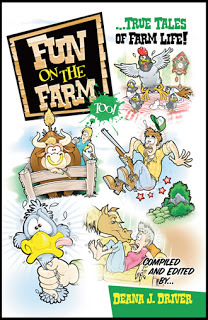
Submission guidelines for all three books:
They must be true stories.Stories should be 750 to 2,500 words.Please provide details including your name, address, phone number, and email address, as well as the names, dates, location, and other details of the people and places in your story. Be sure to get permission to share the stories of others.All submissions will be accepted, but not all will be published.Photos may be submitted upon acceptance of your story.Those whose stories are published will receive two complimentary copies for each story published in that volume of the book and can purchase more copies at a 40% discount to sell at venues not already supplied by DriverWorks Ink.Please send your submission ideas before Jan. 20, 2021 by email to: ddriver at sasktel.net or by mail to: DriverWorks Ink, 110 McCarthy Blvd. N., Regina, SK S4R 6A4. You don’t have to have the entire story written, but we do need to know what will be coming so we can plan our new releases.
Please contact Deana Driver of DriverWorks Ink if you have a story to share but you do not wish to write it yourself. She would be happy to consider writing the story to share it in that way. Thank you in advance.
December 6, 2020
The Good F-words
From my latest e-newsletter:
You know, there are some days – any day during a global pandemic, for example – when you just feel like muttering an “F-word” or two. Believe me, I’ve done it. And will likely do so again. And again.
But just for a change of pace, let me direct your attention to some “good F-words” –
Fun
Farm
Flight
Firefighting
Yes, these are the topics of new books I plan to publish in 2021. Okay, so the Fun and Farm words go together for one book and, yes, Flower, Feather, Fruit, Frosting, and French Fries are also good F-words, but you get my point.
Now let’s get back to today’s topic, shall we?
As mentioned in a previous e-newsletter, I wondered if any of you might have some interesting stories to share for successive volumes in the Fun On The Farmseries and the Flight series of books previously published by my company, DriverWorks Ink. And I also inquired whether there is interest in a new book about the adventures of Volunteer Firefighters in Canada.
I’ve received enough positive feedback – and thank you to those who responded – to forge ahead and ask for submissions to these anthologies. Yep, I'm thinking positively and ignoring the huge constraints this global pandemic has placed on the business of creating and selling books. So please send me your short stories of Fun on the Farm, Flight, and Volunteer Firefighting as per the following guidelines.
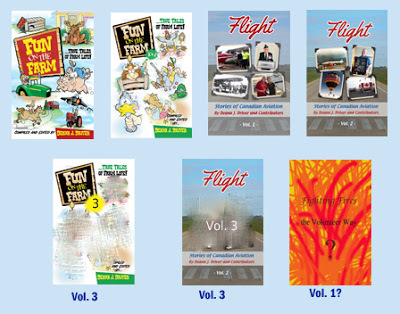
Please write your story or invite someone you know to share their story/stories.
Fun On The Farm, Vol. 3:DriverWorks Ink is pleased to invite you to share more of your true short stories (or poems) about funny things that have happened on Prairie farms for Volume 3 of the Fun On the Farmseries. Tell us about events, interactions, people, or pranks that have happened to you or someone you know related to life on a Prairie farm. We want to make readers giggle, shake their heads in wonder, or downright belly-laugh when reading this book, just as they did with Volumes 1 and 2. Note that I've said "Prairie" farms since most of the stories in the first two volumes happened on the Prairies, but I will entertain stories that occurred on other farms in other Canadian provinces and territories.
Flight: Stories of Canadian Aviation, Vol. 3: If you or someone you know has a great story of Canadian aviation to contribute to the next volume of Flight, please send your submission by email or mail. Submissions must be true short stories (no poems please) about events that occurred to Canadian pilots or other aviation personnel. We want true stories of danger, heroism, helping, joy, adventure, silliness, misfortune, achievement, etc.
Fighting Fires Volunteer-style: Many smaller communities across Canada have a group of volunteers who are called on to help their community when a fire breaks out. Share your true stories of adventure, assistance, humour, struggle, success, and more. Confidentiality may be a concern in sharing these stories, but I will work with you - if your story is chosen for publication - to find a way to tell the story without divulging those identifying details.
Submission guidelines for all three books:
They must be true stories. Stories should be 750 to 2,500 words. Please provide details including your name, address, phone number, and email address, as well as the names, dates, location, and other details of the people and places in your story. Be sure to get permission to share the stories of others. All submissions will be accepted, but not all will be published. Photos may be submitted upon acceptance of your story. Those whose stories are published will receive two complimentary copies for each story published in that volume of the book and can purchase more copies at a 40% discount to sell at venues not already supplied by DriverWorks Ink.Please send your submission ideas before Dec. 31, 2020 to me at DriverWorks Ink. You don’t have to have your entire story or stories written, but I do need to know what will be coming in so I can plan for the new year.Please contact me if you have a story to share but you do not wish to write it yourself. I will be happy to consider writing the story to share it in that way.
Thank you in advance. Happy "F-ing" writing!
November 12, 2020
Second book in the Flight series is taking off!
Alright, that's a corny title for a blog post about the newest book in this series of short stories about aviation, but what can I say? This Flight book series is such a fun project with lots of interesting anecdotes about some great people – and readers are loving it!
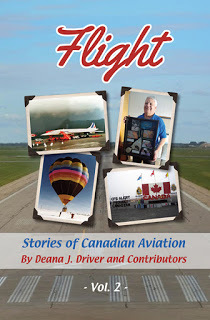
Let me introduce you to a few of the folks you’ll read about in Volume 2 of Flight...
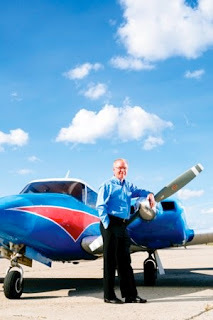 Anglican Bishop of Saskatoon Rt. Rev. Rodney Andrews worked in both ministry and aviation for most of his career across Canada. His list of flying experiences includes working as a part-time instructor with the Lethbridge Flying Club while ministering with the Blood First Nations in southern Alberta, then working with Time Air and Air Canada. He then moved to Quebec for a few years, combining parish work with hospital chaplaincy east of Montreal. From 1988 to 1991, he was in Ottawa working as a part-time chaplain with HMCS Carleton Navy reserve while on a staff with three other clergy at a church in Nepean and working as a full-time Transport Canada inspector. Rod’s had many unique experiences worthy of reporting in a book such as this, including fun connections through his friends in Flying Farmers of Alberta.
Anglican Bishop of Saskatoon Rt. Rev. Rodney Andrews worked in both ministry and aviation for most of his career across Canada. His list of flying experiences includes working as a part-time instructor with the Lethbridge Flying Club while ministering with the Blood First Nations in southern Alberta, then working with Time Air and Air Canada. He then moved to Quebec for a few years, combining parish work with hospital chaplaincy east of Montreal. From 1988 to 1991, he was in Ottawa working as a part-time chaplain with HMCS Carleton Navy reserve while on a staff with three other clergy at a church in Nepean and working as a full-time Transport Canada inspector. Rod’s had many unique experiences worthy of reporting in a book such as this, including fun connections through his friends in Flying Farmers of Alberta.
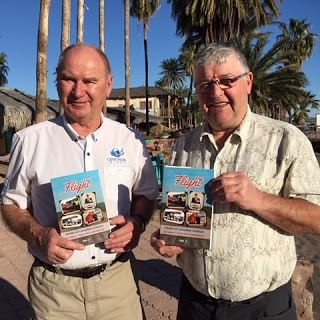
Northern Saskatchewan pilot Doug Chisholm sent me this photo of himself (above right) with his pilot friend Harold Fast in February, while I was putting together the stories for Volume 2. It turns out that Doug and Harold both brought the same book with them to read on their January 2020 trip to Mexico – Volume 1of Flight: Stories of Canadian Aviation, by Deana J. Driver (that's me) and Contributors. How great is that? Doug told me that he and Harold left Saskatoon on a Wednesday and arrived in Loreto, Mexico on a Sunday in Harold’s Cessna 182RG, “a great cross-country aircraft. Quite a spectacular flight in many ways; we saw lots of interesting terrain. I certainly enjoyed your book, which I received from Will Chabun (a retired journalist who has also contributed to the Flight series) when I spoke at the Regina Chapter of the Canadian Aviation Historical Society,” Doug wrote. Doug has owned his Cessna 180 floatplane for 40 years and has recorded aerial photographs of 4,000 lakes and other geographic features that the province of Saskatchewan has named in memory of servicemen who lost their lives during the Second World War. On behalf of families, Doug has placed bronze memorial plaques on the shores of 300 Saskatchewan lakes honouring the servicemen for whom those sites were named, and he has spent thousands of hours uncovering more information and recording it for archival purposes. The story of Doug's memorial efforts is a must-read in Volume 2.
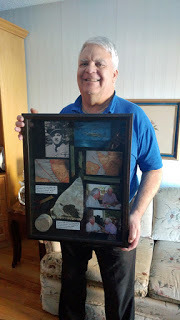
Speaking of the Canadian Aviation Historical Society, I met Gary M. Williams, who is the president of the Regina branch and also the Society's national president, when I spoke to the Regina group in December 2019. In Volume 2 of Flight, you'll read about how Gary travelled to Sweden in 2014 to meet the Swedish woman who saved his bomber-pilot father after his plane crashed in 1942 during the Second World War. I’m sure you’ll enjoy “Shot Down in Sweden” and “The Girl Who Saved My Father”.
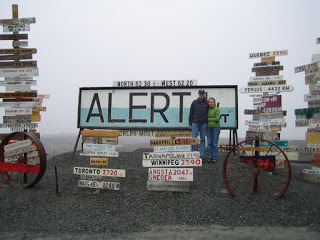
Another one of the 14 stories I wrote for Volume 2of Flight: Stories of Canadian Aviation is about civilian pilot Gerd Wengler, who made a record-breaking flight from Canada’s southernmost point of Pelee Island, Ontario to its northernmost point at CFS Alert. “The year 2009 was the 100th anniversary of powered flight in Canada – Alexander Graham Bell flew the Silver Dart in Nova Scotia in February 1909,” said Gerd. “The Royal Canadian Air Force had all kinds of programs and special things happening in 2009 to celebrate 100 years of powered flight in Canada, so I found this general in Ottawa and I told him my idea as part of the Air Force celebration to fly across Canada from Pelee Island in Lake Erie to Alert. That interested him and I got permission two years later. The DND told us they had never given anyone a permit. That’s why I believe nobody else had done it. The only condition was that I was not allowed to tell anyone until after the flight.”
And then there are stories about Manitoba bush pilot Keith Olson, who dealt with falling aircraft parts, and aircraft mechanic Don Currie, who told of struggling to get French President Mitterrand’s Concorde off the ground in Regina in 1987. You’ll also read about Regina-born pilot Ralph Tweten, who had dozens of adventures while flying in northern Saskatchewan, southern Alberta, the Arctic, and Iran.
Then there are 23 more stories written by 12 other Canadian writers: Will Chabun, a retired newspaperman and aviation historian mentioned above (who wrote stories about newspaperman Foster Barnsley, aviation inspector Howard Ingram, and Air Canada passenger agents Brian Zawacki and Dave Scott); Peter Foster, an aviation enthusiast; Paul W. Greening, an aviation insurance investigator; Alvin Irlbeck, a retired farmer and pilot; Don Macpherson, a flying instructor and retired teacher; Malcolm McLeod, a balloon pilot and former journalist; Harry Meeds, a Saskatchewan pioneer of flight; Vincent Murphy-Dodds, a writer and humorist; Ron Sather, a former pilot; Ron Stansfield, an aviation enthusiast and retired Canadian diplomat; Walter D. Williams, an unofficial air ambulance pilot; and Bill Wunsch, a private pilot.
Volume 2of Flight shares loads of fascinating true stories of early flight schools, northern rescues, animal obstacles, hijackings, errant passengers, landings on unique landscapes, humorous military surprises, and more.
The two volumes of the Flight series are available from www.driverworks.ca, Saskatchewan Aviation Museum gift shop in Saskatoon SK, McNally Robinson Booksellers in Saskatoon SK, Penny University Bookstore in Regina SK, Audrey’s Books in Edmonton AB, Canadian Aviator Magazine, Chapters, Indigo, Coles, SaskBooks, Amazon, and as e-books.
October 24, 2020
Author finds hope in the Questions and Answers of kids
Ed Olfert is a master at sharing hopeful stories. He grew up in Kerrobert, Saskatchewan and found his bride, Holly, near there. They raised their family on their farm while Ed busied himself in a multitude of vocations including mining, working as a welder, driving trucks, doing mechanical work, serving as houseparent in a Christian high school, ministering a Mennonite church, and operating heavy equipment.
In 2015, Ed came to DriverWorks Ink with a collection of hope-filled stories he had written for the Prince Albert Daily Herald. We were honoured to help him publish his inspirational columns, which reflect on his lifelong search for glimpses of God and glimpses of good in everyday life and the people around him. Rather than being preachy, Ed's stories are about family, neighbours, and friends, and include lives that we might not naturally connect to God, to awe and mystery.
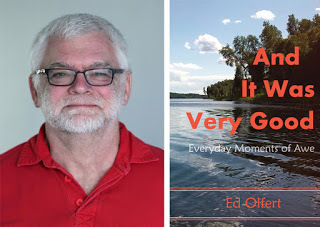
In this time of pandemic, isolation and fear, we need to have hope. We proudly offer one of Ed Olfert’s short stories from his book And It Was Very Good – Everyday Moments of Awe.
This story by Ed Olfert is titled “Hard Questions and Answers”.
"We are in a P.A. carwash when the call comes from our daughter-in-law. Holly’s hand waves suddenly in the window I have just begun to rinse. “We have to go now!”
The rinse will have to wait.
As we head out of town, Holly explains what she was able to understand from the frantic phone call. Our daughter-in-law, her two little boys and her sister, were on their way into town for soccer. On the Muskody Bridge, a motorist appeared to be having problems, and as our daughter-in-law got out to offer assistance, that person plunged over the edge. Our daughter-in-law was part of the attempted rescue effort. Now, she must stay to report in more detail to police. Can we pick up the boys?
When we arrive, the bridge deck is crawling with emergency folks and vehicles. We find our family wedged between two police cars. Our daughter-in-law gets out when she sees us. Hugs are exchanged, tears are shed. Holly opens the back door. Six-year-old Jordan and three-year-old Josh look up at us. Holly asks if they want to come with us. Jordan, who is shaking uncontrollably, whose eyes are huge, simply nods. Josh announces, “I need to bring my toolkit!”
Josh gets out, lugging his tools. He follows me around to the driver’s side of our truck. Holly scoops up Jordan, deposits him in the back seat, takes off her coat and covers him.
The fifteen-minute ride to their house is mostly done in silence, except for Josh’s periodic wondering, “Will the firemen be able to find her?” Jordan’s eyes remain wide. I reach back, put my hand on his knee.
At the boys’ home, Jordan climbs onto the couch. Holly finds a blanket to cover him. His eyes are dark, troubled, confused. Josh, meanwhile, has a need to play aggressively for a time. A dinosaur toy is produced; it is switched on, and as it wobbles noisily across the floor, Josh knocks it over, sets it up, knocks it over again. When he runs off to find another toy to crash, Holly picks up the dinosaur, which is still writhing noisily on the floor. She asks Jordan, “How do I turn this thing off?” A six-year-old’s smirk appears on his face, “You have to push the button on the poop!”
The boys need to talk, not a lot, but need to talk about the bridge experience. Josh repeats several times, “I’m scared, I’m scared of what happened!” He is obviously struggling to find words to express feelings of confusion. Jordan, meanwhile, has less to say – he will internalize this – but he says, quietly, “This has been a horrible day.” He alternates between youthful teasing and giggling and struggling with weighty stuff. “Maybe she was on drugs.” When Josh again wonders, “Do you think the firemen could find her?”
Jordan says in a low voice, “Brother, she’s dead.” Silly moments are interspersed with serious observations and questions.
We sit with the boys for several hours. It feels like Holy time, a time to create a space for these two boys to express, to wonder, to grieve, to struggle to find words to approach this new reality. When you are three or six, it is almost impossible to use language to make sense of this, to touch despair, hopelessness. That is true for parents and grandparents as well, and we sit together in this space where these hard topics might be approached ever so tentatively. Trust seems an important starting point. In this sense, the boys have been well prepared. This is not a time for answers, beyond the undergirding assurance of safety, continuity, love.
That night, the boys sleep well.
As I pondered and prayed through this experience in the past days, I realized that the paths of the young boys’ struggle to sort out deep spiritual complications in life are closely connected to my own. Truly hard issues are not resolved, in my experience, by someone approaching with a truckload of answers. Rather, it is in the identifying of the questions and in the permission to sit with those questions, to live in that tension, to hold that tension loosely. At some point, the deepest questions will change, probably without clearly defined answers, and hints of growth, understanding, wisdom will be left in palms that are held open.
It is an honour to be present, to be invited into that struggle, particularly so when it is written on the clean, innocent slates of young children, struggling to understand, struggling to live with integrity."
And It Was Very Good: Everyday Moments of Awe by Ed Olfert was awarded Honorable Mention, Spiritual, in the 2016 Hollywood Book Festival, Hollywood, CA and was awarded Runner-Up, Spiritual, in the 2016 Great Midwest Book Festival, Chicago, IL.
Buy the book from our website - https://www.driverworks.ca/shop.html
Read a review of the book.
Please contact DriverWorks Ink for permission to reprint any of this article.
September 29, 2020
Not just a walk in the park - Protests, suicide awareness, grief, and hope
Over the last couple of weeks, I have taken several walks or bicycle rides in or near Wascana Park, the largest park in my city of Regina, Saskatchewan. The park usually provides me with comfort and a sense of awe over its beauty and tranquility, but the scenes on one day produced many other emotions including frustration, sadness, surprise, confusion, grief, and peacefulness.
I saw a teepee set up to protest the high rates of suicide in Saskatchewan, a group of anti-maskers holding placards, a garden of flowers, a memorial to a man who drowned in the lake, and the colourful signs of autumn.
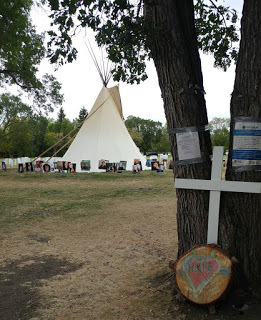
I visited the site where a teepee had been set up across from the provincial legislative building to protest government inaction on high suicide rates among Indigenous persons. I was in awe of the actions of 24-year-old Métis fiddler Tristen Durocher and a supporter, Chris Merasty, who walked 635 kilometres from Air Ronge to Regina to protest the Saskatchewan Party government's decision to vote down a suicide prevention bill put forward by an NDP MLA representing northern Saskatchewan. They began their Walking With Our Angels journey on July 2 and arrived in Regina July 31, where Durocher began a hunger strike and vowed to continue it until meaningful legislation was passed.
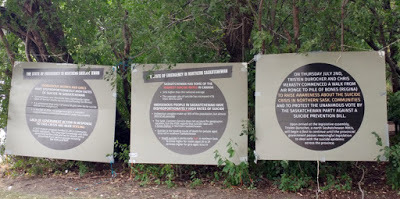
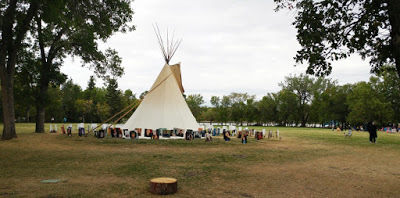
More than 40 photos were placed around the teepee when Durocher started his ceremonial fasting - closeups of individuals who had died by suicide. He had invited others to bring photos of their loved ones lost to suicide. There were almost 90 photos surrounding the teepee on September 12th. It was impossible to not be moved by the spectacle of the faces. So much unnecessary loss and pain. I looked at the faces from a distance and paid my respects silently, with a sad and frustrated heart, hoping for change soon.
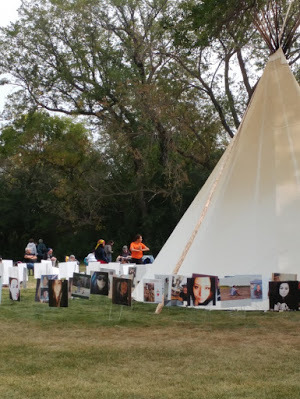
On September 11, a judge had dismissed the provincial government's bid to remove Durocher from the park and allowed him to complete his ceremonial fast and vigil. That judge later visited Durocher at the site, as did numerous individuals from many walks of life, including some politicians and religious leaders. Many discussions were held.
The teepee is gone now, but Tristen's presence on the legislature grounds and his message reached many in this city, this province, and beyond. An online search of his name shows many, many stories of his protest and message. A recent tripartite letter of commitment is a hopeful sign.
As I made my way from the teepee area onto the sidewalk leading to the garden in front of the legislative building, I was taken aback to see a group of people holding signs against mandatory face masking. I was further surprised when one of the woman shouted at me, "We love you!" as I rode by with my face mask on.
I usually wear a mask when I leave my home now - because of my asthma and my desire to keep others safer from any virus or other germs I might unknowingly carry. For a split second, I thought about going back to the protesters to find out what they were thinking, but I decided against it. I was still overwhelmed in thinking about suicide and unnecessary loss of life. I doubted if anything I had to say would change the minds of these anti-maskers. I kept moving - to the garden to enjoy the flowers.

I began my bike ride around the lake and saw, on an area of grass across from the legislative building, a makeshift memorial to another young man who had died by suicide. Twenty-year-old Samwel Uko had drowned in the lake in May. Uko had sought care for mental health issues at a local hospital and had been turned away twice during this pandemic.

The health authority later apologized for its actions. No one had been allowed to go into the hospital to support him or explain the need for his admission. This part of the sad story had hit me especially hard. As one who has made many trips to hospital either with loved ones or to seek treatment myself, I know the crucial role of loved ones as advocates and supports for the patient in health care settings. We have to do better than this.
The rest of my bike ride around and near the lake was thankfully uneventful, punctuated with stops to admire the lake and the changing colours of fall.


Autumn is a time for change on the Prairies. As we prepare for another winter, I hope and pray that we will be kinder, more compassionate and caring of our fellow humans.
Take care. Stay safe. Love one another.
September 5, 2020
Marking an anniversary you don’t want to remember
The last few weeks have been getting to me. Set aside the pandemic concerns about family and friends going back to school, the lack of sales and in-person promotion options for my books and publishing business, and the loss of ability to safely go out into the world and interact with others. Those are all real concerns for me, but the past few weeks have grated on me for another reason.
It’s been five years since my late husband, Al, became suddenly ill with Stage IV colon cancer. I have purposely chosen to not remember the date of his emergency surgery or what day he came home from the hospital. I have not kept track of which days he was readmitted with complications or what day it was that he went back in for the last time. I wrote those details down long ago, mostly for his healthcare providers, but the dates aren’t in my head and I prefer it that way. The timeframe lives in my body though.
Even before a Facebook “memory” popped up with a photo I took when he came home from the hospital after surgery, I was very aware of this time of year. As the five-year anniversaries of these important events come and go, I feel my soul start to hurt again.
The soul, I’ve been told, remembers. The body – made mostly of water – remembers. There’s nothing I can do to stop that pain from flowing through my being and shaking me to my deepest core.
The memories of those moments and events have not come in a visual way, except for that one Facebook photo, which I subsequently hid and will someday delete when I have the emotional energy needed to look at all those photos again. The memories have arrived as more of a feeling that silently crept up on me. A tingling sensation on my nerve endings. A trepidation in my heart. An unexplained unsettled feeling.
Such is the ebb and flow of grief. Even when you are doing well in your life and having mostly good moments and good days, the body remembers and reminds you of the past. You feel in your soul the time of year when a certain event changed your life forever.
It took me a few days to come to terms with these deep-seated feelings.
“Five years,” I kept hearing in my brain. “Five years.”
I tried to ignore it. It would not be quashed.
It rose up like an anniversary that could not pass without some recognition of its significance. So here I am, acknowledging it.
I have survived five years since Al’s emergency surgery. I survived the unexpected worsening of his condition. I survived the unreal, frightening, sad, and peaceful moments of being with him in the hospice. I survived losing him.
For some reason or reasons, I’m still here. He is not, but I am.
It’s surreal and strange. There are times when I can’t believe it, yet I know it’s true.
Five years.
I look around and I’m alone. How did this happen?
But then again, there are many things I’ve done in my life that I can’t believe happened – most of them good and some not as wonderful. This too shall pass. Not the awareness of the finality of it, but the moment of grief. The sadness of recognizing he is gone will go away, but it will come back. Such is grief over the death of one you loved so much.
My head has always known that he is gone. As time goes on, my heart is doing a better job of getting on the same page as my head.
It’s been almost five years since cancer sucked much of the laughter and joy out of my life. That joy was wrapped in the form of a tall, strong, jovial man who is no longer with us. It’s been a heart-wrenching, horrible, complicated, lonely journey for the most part, but I know I've made it through the worst of it.
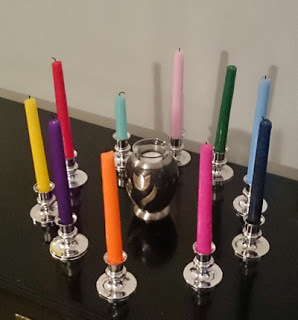
I knew I’d figure out how to be okay. I also knew it wouldn’t be easy.
I am grateful to family, friends, and bereavement counselling sessions for helping me make it this far. I have read book after book. I’ve journalled and cried and exercised and napped. I have talked and talked and talked with anyone who would listen, even after many of them stopped wanting to hear it. I have stared at the television for hours on end, looking for a respite from my agony, from the thoughts in my head, the hole in my heart, and the fears and emotions bubbling to the surface.
Taking one step at a time, with my own inner demons and thoughts, I’ve made it this far. And I plan to keep going.
Losing him became my measurement for today. What's happening in this moment and how does it compare to that loss? So far, nothing has come close to that devastation, for which I am grateful.
When Al became ill, he chose to fight. We had been together for four decades. There was no question that we would fight his cancer together. We followed doctors’ orders and lived in the moment as much as we could. We chose to not live in fear. It was the best way to live. It is the best way to live.
We dealt with what was in front of us – the things we could control – and we let go of the rest. It is easier to do that when a life-changing situation hits you in the face and you have to set aside much of your daily routine to focus on the moment. "Living in the moment" doesn’t have the same immediacy when things are going along smoothly, but it is important. Crucial, really.
We laughed, we loved. We hugged and enjoyed each other’s presence. Al told stories and teased us all until the illness robbed him of energy and life. I recorded some of his best stories and the conversations he had with visitors at the hospital so I could look back at those videos someday and smile. That someday is not here yet.
Five years is too soon for me to watch videos of what I've lost. I've managed to listen to a voice recording from 2012 during which I rolled my eyes at his strange sense of humour. When I hear that recording now, it makes me laugh. Sometimes when it pops up in my music feed on my phone, though, it hurts and the tears come. My loss is still profound, affecting most of the moments of every day, but I am okay.
I have carried on and added to my life after loss with some new friends, new social activities, a foray into the dating world (the jury is still out on that front), and a better grasp on what I am willing to accept and dismiss in this precious life of mine.
It’s one of the many lessons I learned from Al’s death. I not only need to set better boundaries for my own well-being, I need to be okay with the disappointment of others when I stick to my boundaries. I need to look after my own physical, spiritual, mental, and emotional health. I need to seek out the things that make me happy and spend my time with the people who bring joy to my life – from a safe physical distance or in other ways that I can manage during a moment.
It’s been five years, but sometimes it still feels like yesterday.
The bigger anniversary – five years since his death – is coming yet. But I think I’ll be okay with it.
I’ve learned that the anticipation leading up to a birthday, anniversary or other major event connected to a deceased loved one is often worse than the actual day of the event itself. By talking about this anniversary, even in its loosest form without specific dates, I have taken away some of its power over my body. Maybe my soul can release more of that pain and bring forth more of the happy memories. For there are a boatload of them, as Al would say. A big, happy boatload of memories and stories. It's my job to keep those alive in my soul.

August 25, 2020
Books and beauty in Medicine Hat
In July, I travelled to the beautiful city of Medicine Hat, Alberta to visit family. It had been six months since I'd seen my oldest daughter, Lisa, and her family in person. The only other time Lisa and I were apart this long was when she was travelling in Europe after completing university in Calgary. Both of those time periods felt like an eternity.
The past six months of not seeing her face-to-face, hugging her, and making in-person plans for our next book projects as authors and co-publishers was especially long with the added stress of COVID-19. I missed her and her husband, Kyle, and their two daughters, especially as the youngest was learning to talk. So when one of my closest friends invited me into her pandemic bubble to go along for a drive to Alberta, I gladly accepted. We'd both been careful about self-isolating, sanitizing, and wearing face masks when we occasionally went out in public in our city of Regina, and we continued with precautions on our journey west.
Medicine Hat is a lovely city, with the South Saskatchewan River, the hills and coulee/ravine adding to its beauty. Deer can be seen wandering through the neighbourhoods and the people who live there are typical, friendly Canadian Prairie folk who help each other out and care for their community.
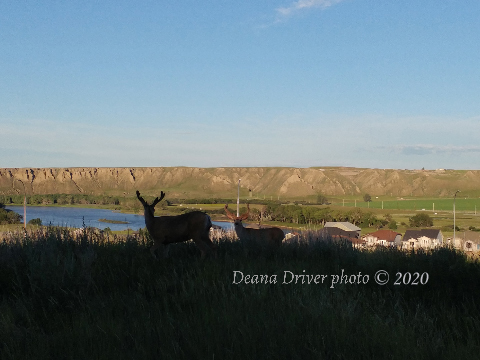
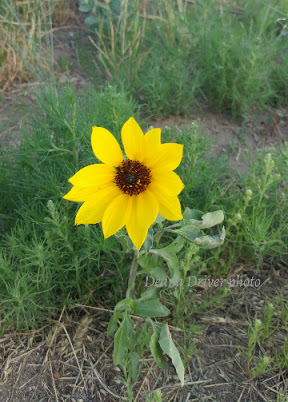
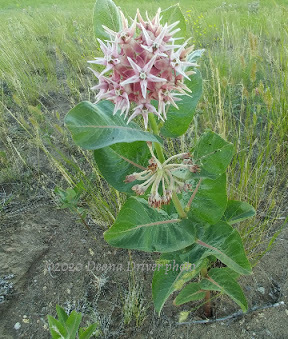
The efforts to revitalize the downtown area of Medicine Hat include numerous wall murals that Lisa and I enjoyed during a morning work break.
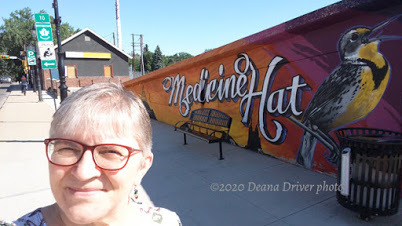


We also talked about our newest book ventures - my two volumes of Flight: Stories of Canadian Aviation and the newest spiritual guidebook that Lisa is writing to add to her other three great guidebooks. This is exciting stuff!
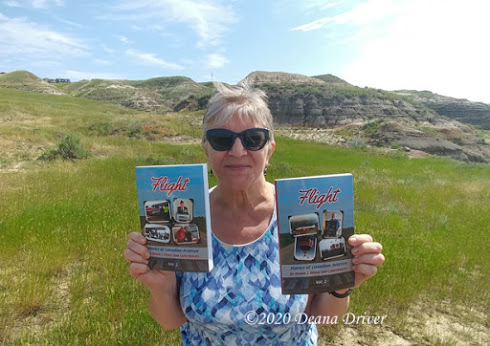

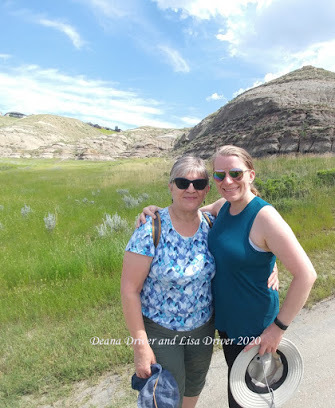
Watch the video we shot in The Hat for details, including the title of Lisa's upcoming book!
All in all, it was a soul-filling visit with much opportunity to work and play with some of my favourite people.

P.S. You can purchase your copies of Flight: Stories of Canadian Aviation here on the DriverWorks Ink Shop page. The books are also available as e-books from your favourite e-book vendors.
Special thanks to Creative Saskatchewan for its Book Publishing Production Grants support for the Flight series.
July 23, 2020
Pookie the Bunny brings some creature comfort during COVID-19
Meet Pookie – the bunny that has decided to relax or just munch on grass and weeds in my backyard when he’s not hopping around elsewhere.
Yes, Pookie.
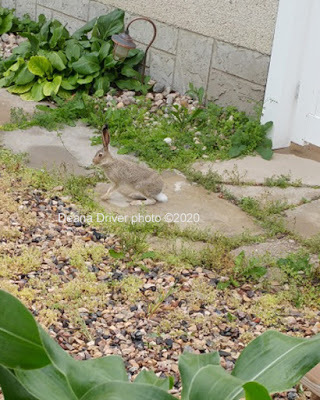
Pookie came to visit me a few weeks ago and has since decided to make my yard a regular stop on his tour of the neighbourhood. Pookie was much smaller when he first arrived, so I knew he was a bunny and not a full-fledged rabbit yet. I wondered if I’d someday find a whole litter of bunnies out by the back fence or chewing the tops off my daylilies and generally being a nuisance. So far so good.
I watched Pookie chew on what I hoped were thistles and dandelions in my lawn one day. I started to warm up to him a little more from that moment on.
For a few days, when I had to do some serious weed control, I covered up a couple spots where I knew he was crawling under the fence to come in and out of my yard. I thought maybe I would be better off without a wascally wabbit on my property after all. Then there he was one day, just resting by my garden boxes, looking at me with one of his dark eyes, ears down as if he wasn’t the least bit concerned that I was walking on his land. It turns out I hadn’t closed off all the spots where he could sneak in and out of my yard. Now what should I do?
A friend who is a proponent of the “live and let live” philosophy suggested that the bunny may have come to keep me company during the pandemic. I had wondered about this myself, being a person who believes in angels and spiritual signs from departed loved ones. I’ve seen a lot of robins this year – almost every time I think of my late husband, in fact. And a bluebird came and sang loudly in my front yard a couple times when I was working on landscaping and thinking of my departed mother. Why not a bunny bringing messages of love and support?
I have not seen a rabbit in my yard - front or back - in the 12 years since we moved to this busy street. And now, in the 13th year (13 was my late husband's favourite number), a bunny has appeared and a larger rabbit sometimes shows up in the front yard too.
Pookie has certainly lifted my spirits some days. I found that I actually missed him on the days when he was gone.
So be it. Live and let live.
He has not yet figured out how to get up into my garden boxes to eat the peas and carrots, so as long as he sticks to the grass and weeds, he can stay.
Pookie comes and goes as he pleases, of course, and I am pleased and intrigued to see him when he’s here. He has scared the bejeebers out of a me a couple times and I’ve scared him – rabbits are quiet beings and I didn’t see him hiding in the front shrub that time or on the back lawn yesterday while I was watering plants but, for the most part, we coexist quite nicely.
Friends have told me they named the rabbit that visits their yards, so I thought my bunny’s name would be Velvet, after one of my husband’s favourite children’s storybooks, The Velveteen Rabbit by Margery Williams. It’s a story about how a stuffed bunny wants to become real through the love of his owner. I thought I had Al's childhood copy of The Velveteen Rabbit somewhere, so when I went looking for it I was surprised to find that I was wrong. This was not the book I have been holding onto for decades.
Published in 1959 and addressed to my husband from a neighbours’ two children, Pookie’s Big Day by Ivy L. Wallace tells the tale of a bunny with wings who lives with his person, Belinda, in a little cottage in Bluebell Wood. Belinda is celebrating her birthday and Pookie has woken early to gather violets and elderberries for his friend. Pookie has such a great day celebrating with Belinda and all the woodland friends that he wishes every day could be this much fun, but he soon learns that this wish would not be such a good idea.
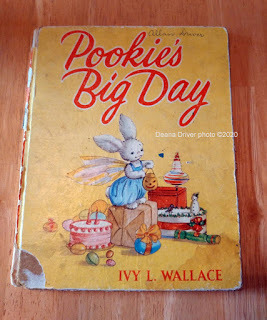
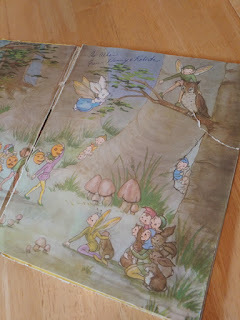
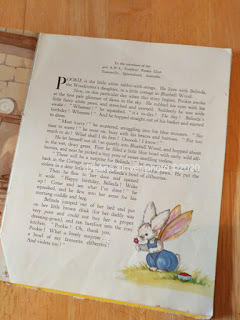
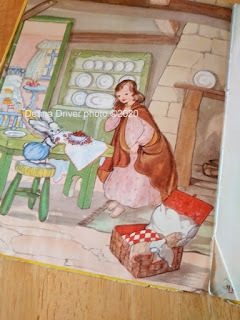
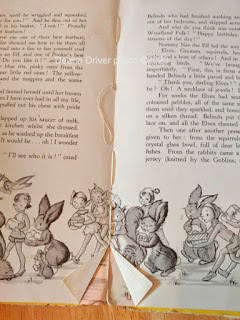
It’s a lovely little story so, in honour of both this hardcover, string-bound book from decades ago and my husband Al, I’ve named my rabbit visitor Pookie.
In thinking a bit more about the origin of this bunny's name, I now know that this creature definitely has to be connected to my late husband. Al could not possibly allow my little rabbit to have a classy name like Velvet. Oh no. Not my mischievous Al. I can see him smirking away as he teasingly calls the rabbit, "Heeere, Pookie... Come on, boy! Pookie, Pookie, Pookie!"
Oh my. Al still makes me smile and occasionally laugh out loud.
Little Pookie doesn’t know his name, of course. And I’m not sure I will ever get that friendly with him to call him by name yet. I grew up on a farm and I know that I could be asking for trouble by allowing him to stay. We’ll see.
For the time being, I’ll allow him to seek refuge in my yard and I’ll try not to scare him if he promises not to scare me.
Pookie is a reluctant photo subject but he is sometimes patient enough to sit still or at least mostly within the camera frame while I attempt to take a half-decent photo or video from a safe distance.
So here you go – enjoy another glimpse of Pookie, my furry little friend.
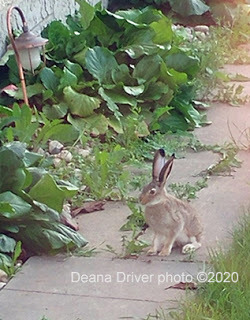
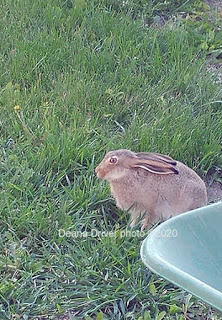
Maybe he’ll give you a little smile and a mental break from the stress and strangeness that is 2020.
Have a Hoppy Day, everyone!



